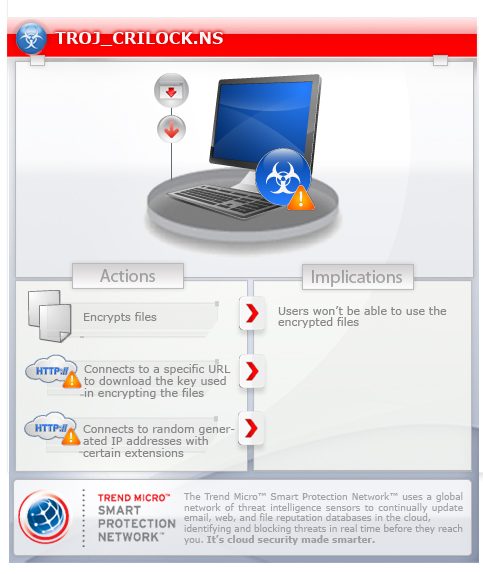TROJ_CRILOCK.NS
Trojan:Win32/Crilock.B (Microsoft), Trojan.Ransomcrypt.F (Symantec)
Windows 2000, Windows Server 2003, Windows XP (32-bit, 64-bit), Windows Vista (32-bit, 64-bit), Windows 7 (32-bit, 64-bit)


Threat Type: Trojan
Destructiveness: No
Encrypted: Yes
In the wild: Yes
OVERVIEW
This CryptoLocker is downloaded by a ZeuS/ZBOT variant detected as TSPY_ZBOT.VNA. When executed, it encrypts files and asks users to purchase a decrypting tool.
To get a one-glance comprehensive view of the behavior of this Trojan, refer to the Threat Diagram shown below.

This Trojan arrives on a system as a file dropped by other malware or as a file downloaded unknowingly by users when visiting malicious sites.
TECHNICAL DETAILS
Arrival Details
This Trojan arrives on a system as a file dropped by other malware or as a file downloaded unknowingly by users when visiting malicious sites.
Installation
This Trojan drops the following copies of itself into the affected system and executes them:
- %Application Data%\{random GUID}.exe
(Note: %Application Data% is the current user's Application Data folder, which is usually C:\Documents and Settings\{user name}\Application Data on Windows 2000, XP, and Server 2003, or C:\Users\{user name}\AppData\Roaming on Windows Vista and 7.)
It adds the following mutexes to ensure that only one of its copies runs at any one time:
- {random string 1}
- {random string 2}
Autostart Technique
This Trojan adds the following registry entries to enable its automatic execution at every system startup:
HKEY_CURRENT_USER\Software\Microsoft\
Windows\CurrentVersion\Run
CryptoLocker = "%Application Data%\{random GUID}.exe"
Other System Modifications
This Trojan adds the following registry keys:
HKEY_CURRENT_USER\Software\CryptoLocker
HKEY_CURRENT_USER\Software\CryptoLocker\
Files
It adds the following registry entries:
HKEY_CURRENT_USER\Software\CryptoLocker
PublicKey = “{random values}"
HKEY_CURRENT_USER\Software\CryptoLocker\
Files
{path and file name of encrypted file} = “{hex value}”
It adds the following registry keys as part of its installation routine:
HKEY_CURRENT_USER\Software\CryptoLocker
HKEY_CURRENT_USER\Software\CryptoLocker\
Files
NOTES:
This Trojan attempts to download the key to be used in encrypting files by connecting to random generated domains with the following extensions:
- biz/home
- co.uk/home
- com/home
- info/home
- net/home
- org/home
- ru/home
It encrypts files with the following extensions:
- *.3fr
- *.accdb
- *.arw
- *.bay
- *.cdr
- *.cer
- *.cr2
- *.crt
- *.crw
- *.dbf
- *.dcr
- *.der
- *.dng
- *.doc
- *.docm
- *.docx
- *.dwg
- *.dxf
- *.dxg
- *.eps
- *.erf
- *.indd
- *.kdc
- *.mdb
- *.mdf
- *.mef
- *.mrw
- *.nef
- *.nrw
- *.odb
- *.odc
- *.odm
- *.odp
- *.ods
- *.odt
- *.orf
- *.p12
- *.p7b
- *.p7c
- *.pdd
- *.pef
- *.pem
- *.pfx
- *.ppt
- *.pptm
- *.pptx
- *.psd
- *.pst
- *.ptx
- *.r3d
- *.raf
- *.raw
- *.rtf
- *.rw2
- *.rwl
- *.sr2
- *.srf
- *.srw
- *.wb2
- *.wpd
- *.wps
- *.x3f
- *.xlk
- *.xls
- *.xlsb
- *.xlsm
- *.xlsx
It uses AES-265 and RSA encryption. Decrypting the encrypted files is not feasible as of this writing.
It demands users to pay a fine via any of the following payment methods:
- Bitcoin
- cashU
- MoneyPak
- Ukash
SOLUTION
Step 1
Before doing any scans, Windows XP, Windows Vista, and Windows 7 users must disable System Restore to allow full scanning of their computers.
Step 2
Restart in Safe Mode
Step 3
Delete this registry value
Important: Editing the Windows Registry incorrectly can lead to irreversible system malfunction. Please do this step only if you know how or you can ask assistance from your system administrator. Else, check this Microsoft article first before modifying your computer's registry.
- In HKEY_CURRENT_USER\Software\Microsoft\Windows\CurrentVersion\Run
- CryptoLocker = "%Application Data%\{random GUID}.exe"
- CryptoLocker = "%Application Data%\{random GUID}.exe"
Step 4
Delete this registry key
Important: Editing the Windows Registry incorrectly can lead to irreversible system malfunction. Please do this step only if you know how or you can ask assistance from your system administrator. Else, check this Microsoft article first before modifying your computer's registry.
- In HKEY_CURRENT_USER\Software
- CryptoLocker
- CryptoLocker
Step 5
Restart in normal mode and scan your computer with your Trend Micro product for files detected as TROJ_CRILOCK.NS. If the detected files have already been cleaned, deleted, or quarantined by your Trend Micro product, no further step is required. You may opt to simply delete the quarantined files. Please check this Knowledge Base page for more information.
Did this description help? Tell us how we did.



